Listed 100 (total found 158) sub titles with search on: Sights for wider area of: "SOUTH AEGEAN Region GREECE" .
LEROS (Island) DODEKANISSOS
Leros architecture its a blend of 4 deferent styles, the typical style of Dodecanesewhich has a lot of similarities with the architectural style of the Cyclades islands, smallwhite houses with blue painted doors and windows. The neoclassic style with the dominant color of okra and finally the remaining Italian buildings from the times of the Italian occupation which most are in Laki and mostly good remain as a living museum of Mussolini's architecture.The last decade the modern lerians build there houses with respect to the traditional local style.

PANO KALAMONAS (Settlement) RHODES
ASKLIPIOS (Village) NOTIA RODOS
The old cella of the church in the village Asklepeio, is a simple, one-roomed ground floor structure, almost cubical in shape. The stone masonry follows the local, traditional style and the floor is made of beaten earth.
It was built in 1879 and it functioned as the storeroom of the church, where oil was kept in large, clay storage vessels (pithoi), some of which are still preserved.
This text is cited Feb 2003 from the Hellenic Ministry of Culture URL below, which also contains image.


ASTYPALEA (Port) DODEKANISSOS
The Astypalean traditional houses are similar to those of the Cyclades.
Moreover, the cycladic colour seems as though it surpasses the Dodecanese
colour around the island.
The most interesting part of the house other than the fireplace and
the divisions of the walls is the wooden loft in the far part of the room decorated
with lace, woodwork, which was used as a bed. It has a height of about two metres
and to reach it, one must climb a ladder, which is formed by three wooden trunks,
one placed on top of the other.
Next to the bed, three or four rows of carved, wooden shelves make
up the "Krijola", on which the most beautiful and the best glassware
of the housewife are kept.
The wooden ornamentation of the bed, the "Krijola", the
door and window cases, and the ceiling is a sample of the excellent woodcarving
craftsmanship was developed in Astypalea.
One of the most characteristic pieces of work of this art is the carved,
wooden ceiling of one of the houses inside the Castle the only one which has been
saved today.
This text (extract) is cited November 2003 from the Municipality
of Astypalea tourist pamphlet (1999).
CHALKI (Island) DODEKANISSOS
Photo Album in URL, information in Greek only.
POSSIDONIA (Village) SYROS
Possidonia was the place chosen by the island's wealthy families for their country retreat, at the turn of the last century. A number of villas were built in the grand neoclassical style of the time. Today, some are open to the public.

PROFITIS ELIAS (Settlement) RHODES
The hotel is on mount Prophetes Elias, near the Byzantine monastery with the same name. It comprises tow buildings, a three-storeyed one, "Elaphos" and a two-storeyed one, "Elaphina", both with a basement and a high pitched, wooden roof. The walls are built of stones in a cement frame, while all the window frames and balconies are made of wood.
The "Elaphos" hotel was the first part built by the italians in 1929 (Albergo del Cervo). In 1930, a ground floor restaurant with a large veranda, a tennis court and a dancing floor were added while later on, the second floor was constructed, replacing the veranda. In 1932 the building was extended with a new wing, called "Elaphina". Thus, the hotel was finally named "Elaphos and Elaphina" after a certain species of deer that lives in the woods nearby.
Today the hotel is abandoned.
This text is cited Feb 2003 from the Hellenic Ministry of Culture URL below, which also contains image.


RHODES (Town) DODEKANISSOS


Tel: +30 22410 36710, 30668
Fax: +30 22410 30668
Tel: +30 22413 60530
Fax: +30 22413 60547
The two-storeyd stone building is simple, almost square in plan, and has a pitched, tiled roof. Decorative horizontal bands are used on the exterior surfaces of the walls, under the roof and between the two floors. The building has a large, fenced yard, both in the front and the back. In the backyard, a characteristic postico and a marble fountain are still preserved.
The building was constructed in 1874 and it is one of the first organized christian schools of Rhodes. It is a a continuation of the "Mutual Teaching School", founded by the metropolite of Rhodes, Paisios. The building was constructed on an older one, built in 1765, which occupied the large, communal piece of land, that extended up to the modern Venetokleion.
Today it is used as a primary school.
This text is cited Feb 2003 from the Hellenic Ministry of Culture URL below, which also contains image.


The hotel was built during the Italian occupation of the island and it is an imposing building of great architectural interest as its volume is broken up into smaller units, making the structure more complicated. Its simple form, the arcaded facade andthe garden, are still an integral part of the modern city of Rhodes.
The building has two architectural phases:
It was designed by an italian architect, Michele Petracco in the early 1920's and was built in the style of Oriental Eclecticism
Later on, in the priod of the italian fascism, starting in 1936, the dominant archittectural style) resulted in several changes in the form of the building: the oriental features (arcs, domes, apses etc.) were diminished and the structure came to its present form.
Today the building is abandoned.
This text is cited Feb 2003 from the Hellenic Ministry of Culture URL below, which also contains image.


The building of the Post Office is located on the Liberty Square (Plateia Eleftherias) of the modern city of Rhodes. It is an excellent specimen of the Rennaisance Eclecticism and the "Finta Pietra" technology . The facade is richly decorated with reliefs carved on local poros stone. The impressive main entrance is in the centre of the building and symmetrical openings are left on each side. The building was constructed during the first years of the Italian occupation by the Italian architect Florestano di Fausto. It was then used as the Italian Post-Office (Palazzo delle Poste) and its function today remains the same, as it houses the Greek Post-Office (ELTA).
This text is cited Feb 2003 from the Hellenic Ministry of Culture URL below, which also contains image.


It is a stone, neoclassical building with tiled roof. The ground floor is Pi-shaped in plan and only the central part is two-storeyed. The main entrance is located in the groun floor, in a recession behind a porch with two columns in the middle and two pillars on each side. The building was constructed in the end of the 19th century by a donation of Paul Kazoulis. In 1930, by a donation of Michael Kazoulis, Paul's nephew, the second floor was added and it was called "The Upper Kazouleion". Today it is used as the Second Primary School of Rhodes.
This text is cited Feb 2003 from the Hellenic Ministry of Culture URL below, which also contains image.


The Hospice of St. Catherine was built in 1391-92, under grand master
Heredia, by the Italian Domenico d'Allemagna, admiral of the Order of the Knights
of St. John (Knights Hospitaller). The founder was an important personage, disposing
of considerable means. The foundation charter of the Hospice in 1391 states that
it was «founded in the burgus of Rhodes, near the walls at the gate leading to
the mole» already known as the «Gate of St. Catherine» from 1465. The situation
of the building draws the eye, as it projects into the axis of the high street;
the salient part carries the coats of arms of 1516. The Hospice, exclusively intended
for eminent guests of the Order, was already in use from 1394-95; at this date
traveller Niccole de Martoni described it as «beautiful and splendid, with many
handsome rooms containing many and good beds». The building was apparently destroyed
in the siege of 1480 and the earthquake of 1481. Its rebuilding, as testified
by the heraldy on the west faηade, was completed by Costanzo Operti in 1516, when
Fabrizio del Carretto was grand master.
In 1944 the east part of the Hospice was destroyed by Allied bombing,
along with many building in the heart of the Jewish quarter. In the years following,
the surviving part stood forlorn in a deserted neighbourhood. It was occupied
by poor immigrants from the neighbouring islands until 1986, in slum conditions.
The Hospice of St. Catherine was one of the 20 state-owned properties
under the jurisdiction of the Archaeological Receipts Fund entered in the restoration
programme of the Office of the Medieval Town, founded in October 1985. Its restoration,
in the following ten years, was a complex process involving:
a) The social problem of rehousing 16 households hitherto accomodated within the
Hospice (1986-1995).
b) Archaeological investigation of the site (1987-1993).
c) Urgent rescue measures, carried out alongside the restoration of the Hospitaller
masonry and structural examination (1986-1991)
d) Completion of consolidation measures and the architectural restoration of the
standing part of the Hospice (1992-1995).
e) Conservation of medieval and traditional features by specialists.
f) Restoration of the collapsed east side of the building (1994- ).
g) The integration of the restored Hospice «Heritage Educational Centre» into
the surrounding archaeological sites, in order to facelift the area and attract
the visitor of the historic centre.
This text is cited Feb 2003 from the Hellenic Ministry of Culture URL below, which also contains images.



It is a stone, neoclassical building, with basement and groundfloor, a tiled roof and a broad staircase in the front. The facade of the projecting, central part, is dominated by six large columns, in front of the main entrance. The plan of the building is actually cross-shaped, and a variety of decorative elements are visible on all sides: decorative bands, corner antae, built-in pillars etc. The building was constructed in 1910 by a donation of Venetokles and it occupied part of the large communal piece of land, that also included the Kazouleion and the Astike School. Today it is used as the High School of the City of Rhodes.
This text is cited Feb 2003 from the Hellenic Ministry of Culture URL below, which also contains image.


Ιt is a two-storeyd building with flat roof and an arcade looking towards the road by the sea. The walls are built in the typical, local isodomic masonry. Very interesting is the structure of the interior, visible in the plans of the building. Ιt was built in the first period of the italian occupation (1925) and in its first phase it was richly decorated in a combination of the oriental and gothic styles. From 1936 onwards, when De Vecchi was the govenror, all the decorative elements were removed so that the facade was in accordance with the official architectural style of the state (Fascist Style). The building was called "Circolo Italia" and was used as a meeting place by the italian officers. Today it has been transformed into a coffee and pastry shop.
This text is cited Feb 2003 from the Hellenic Ministry of Culture URL below, which also contains image.


It is a stone, neoclassical building with basement and ground floor and a tiled roof. The main entrance of the building is located in the middle of the facade, in a large recess framed by four columns. All the outer surfaces of the walls are decorated with bands and pillars around the windows. The school was built in 1911 by a donation of G. and D. Amarantos. Today it is used as the Primary School of the City of Rhodes.
This text is cited Feb 2003 from the Hellenic Ministry of Culture URL below.


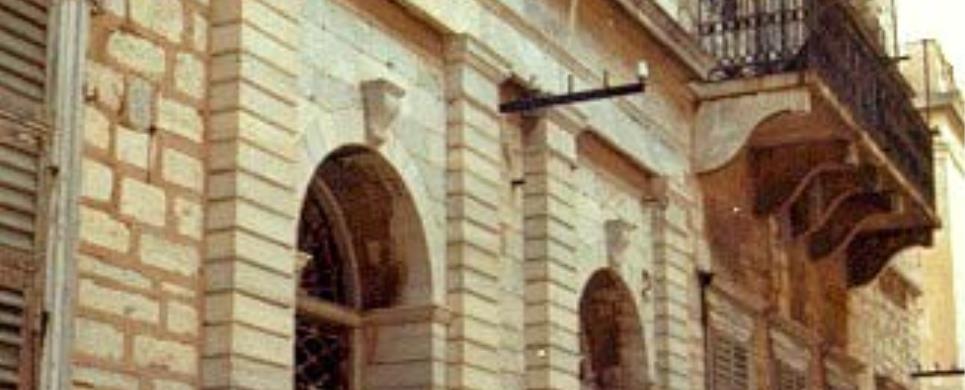
SYROS (Town) KYKLADES
Tel: +30 22810 79133
Massive building of monumental style with simple
architectural lines and interesting construction. It has marble-built parts
with furrow joints while marble stripes separate the stories and a cοnvex and
concave moulding sets off the edifice's base. The final cornice is of marble and
there is also a built parapet around the chamber. The building could well be described
as an apartment building since it had different entrances. Morphologically
and historically, the building is significant. As it can also be seen at the signposts,
there lived Ch.A.Kriaras, resided King Otto and stayed E. Venizelos while an infant.
From 1935 to 1963, it served as a Girls' Highschool.
By a ministerial decree of 1987, the building was identified as a
work of art encircled by a protection zone extending to the property's boundaries.
Today, part of the building is inhabited while the rest is empty.


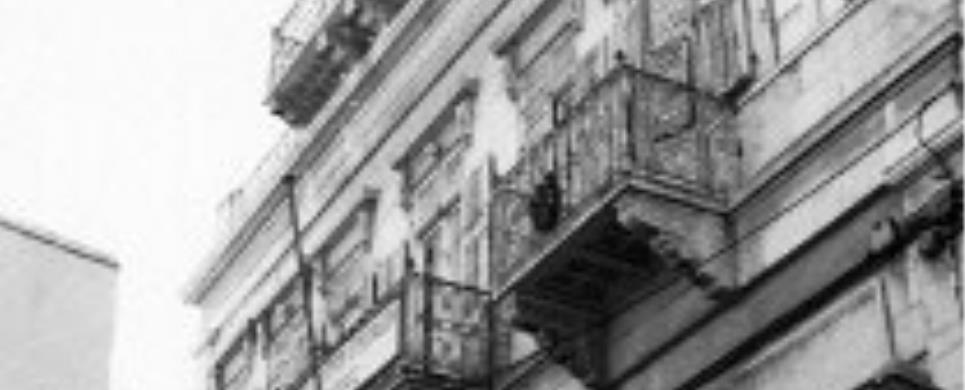
Tel: +30 210 3253059, 3243289
Fax: +30 210 3232547
The building is a mansion of heavily decorated architecture in the outside and
interesting adornments inside. It is marble-built with masonry ashlar and a gable
pediment on the third floor's shaft. Among its characteristic elements are the
well-worked arched openings of the ground-floor shops and the decorations of exceptional
technique on the stories (balcony windowsills, window cornices with legs dentils.
The mansion was built by the architect, T. Vlysidis from the island of Syros.
After its recent repair, the wall-paintings were destroyed (mainly
those in the stairwell).
By a ministerial decree of 1987, the building was identified as a
work of art encircled by a protection zone extending to the property's boundaries.
The first Secondary School of Hermoupolis is situated behind the Town Hall. Founded in 1833, it was the first of its kind, not only in Hermoupolis, but in the whole of Greece. Together with the Secondary School of Nauplion, these were the first buildings constructed especially for this purpose. It is a two-storeyed building, ornately decorated along the central part of the first floor. It was designed by the Bavarian architect Herlaher and it was inaugurated on the 13th of November, 1834. According to an inscription at the entrance to the building, its first headmaster was Neofitos Vamvas. It has comfortable, high-ceilinged rooms. In the central hall on the first floor, we see a large frescoe of the Parthenon. Not only children from Syros studied there, but also from Chios, Psara and Crete. The school counts among its pupils such eminent figures as Eleftherios Venizelos, Dimitrios Vikelas, Andreas Sigoros, Klon, Kiparissos Stefanos and others.
This text is cited Apr 2003 from the University of Patras' XENIOS DIAS website URL below.


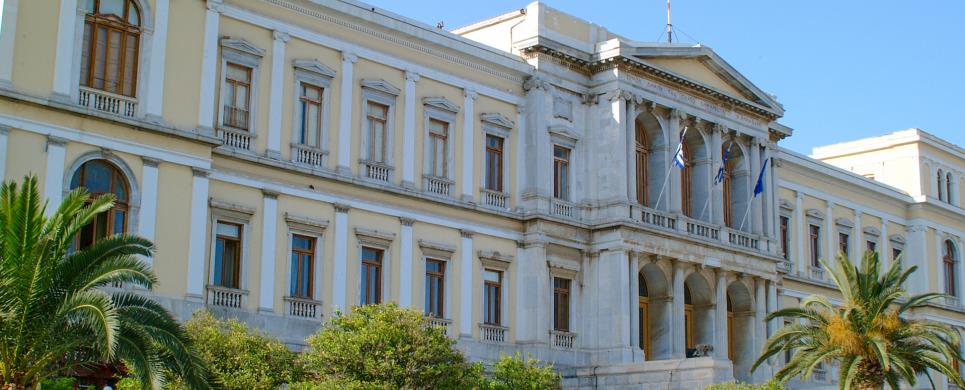
Tel: +3022813 61000
Fax: +3022810 88232
TINOS (Small town) KYKLADES
Chora boasts a number of neoclassical houses, built by the bourgeoisie of the 19th century.


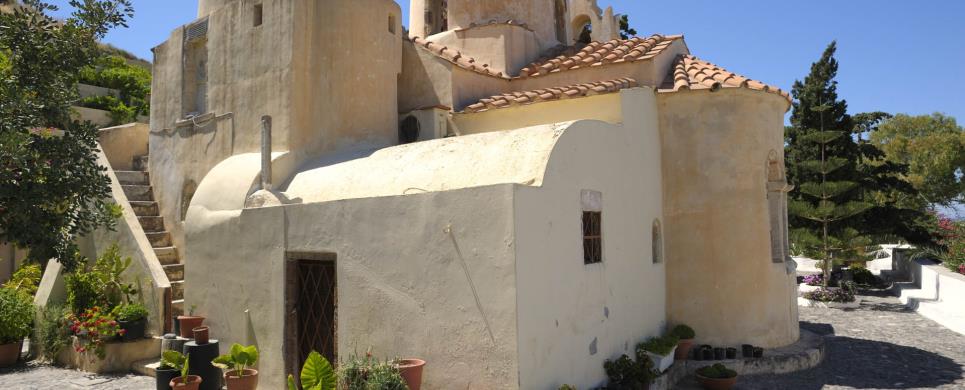
EPISKOPI GONIAS (Village) THIRA
Tel: +30 22860 31451
AGIA MARINA (Small town) LEROS
AGIOS IOANNIS (Beach) ASTYPALEA
AMORGOS (Village) AMORGOS
Venetian Castle - Hora the capital of Amorgos, is a small town hidden behind the mountains, At its south-eastern edge the hill is crowded with the old wind mills. The "Kastro" -castle rock rises out of the village, as a guardian of Hora, over the years since the Venetian occupancy. The historic rock with a height of 210 feet wedges for more than fifteen centuries the church of Kera Leousa (our Lady of mercy), the oldest one in Chora, A narrow stone staircase in the rock, leads to the small St. George Church from which the entrance to the fortress with its preserved low gate is. Around the rock's base,
spread the old stone buildings and forty churches of very interesting architecture.

ANDROS (Small town) KYKLADES
It was built in 1207 and all the building work lasted for 26 years. You can see it just at the end of the peninsula of Hora - Andros town opposite the square of "the Unknown sailor".The little island on which the imposing Venetian castle is built , is connected by Hora with a little stony arch.
The castle used to be a fort to protect Hora in the past. However , its greater part was destroyed during the second world war.
ANTIMACHIA (Small town) KOS
It is located 4km to the SE of the village of Antimachia.
ASKLIPIOS (Village) NOTIA RODOS
Above the village of Asklipios, after a 15 minute walk, visitors will
find the ruins of a medieval Crusader castle. After an impressive entrance, there
is little to see inside the castle except for good views over the countryside
but care needs to be taken for uncovered wells. As the story goes, there was at
one time a tunnel from one of the houses to the castle so that villagers could
secretly gain refuge from raiding pirates.
This text is cited Oct 2002 from the Rodos Hotels Association URL below.

ASTYPALEA (Port) DODEKANISSOS
The Venetian Castle, with its two whitewashed churches, stands proudly
at the top of the peninsula proclaiming the onset of the development of the settlement.
As the centuries progressed little white houses began to appear outside
the walls of the Castle, which covered the hill and reached the port of Pera
Yalos joining together to form a mosaic of our island’s history.
The portrait of Chora with its white body and ocean blue heart, leaves the visitor speechless because of its beauty and harmony. The Castle takes up all the plateau at the top of the hill. That densely
built group of houses there made up the Middle Ages settlement. Today, only a
few of the houses have survived, the out sidewalls of which make up the walls
of the Castle. Only on the south side there is a strong battle tower, which is
known by the name "Serai". Inside the Castle, among the scattered columns
and the carved stones, two beautiful churches, Panagia of Castro (the Holy Virgin
of the Castle) and Agios Giorgios (Saint George) stand.
This text (extract) is cited November 2003 from the Municipality
of Astypalea tourist pamphlet (1999).
CHALKI (Island) DODEKANISSOS
Photo Album in URL, information in Greek only.
CHORA KALYMNOY (Small town) KALYMNOS
EXOMVOURGO (Municipality) TINOS
The highest mountain of Tinos (640m) is the location the Venetians chose for their castle in 1207. They surrounded this stronghold by two enormous buttress-walls. It is the most strategic spot on the island. In 1901, a huge marble cross was erected on its summit. The cross was destroyed in 1915, and restored in 1931.
HERAKLIA (Island) KYKLADES
These are the remains of a castle of Hellenistic Period (323 b.c-316 b.c.). Also
found are the ruins of the temple of Zeus and that of the Goddess of Luck. It
was a settlement until 1930.


KALYMNOS (Town) DODEKANISSOS
The mountain top Fortress at Hora, the island's ancient capital. This
was established as a fortress in the Byzantine period and was occupied until the
18th century. Now, just nine chapels remain standing. Open Monday - Sunday 08.00
- 20.00.
The ruins of the Church of Christ of Jerusalem, located between Hora
and Panormos, are on one of the oldest sites in Kalymnos. The church was built
on the site of the ancient Temple of Apollo, god of light and music and the defining
deity of Kalymnos. His lyre remains to this day the island's proud symbol.
The Citadel of the Knights is on a steep rock just inland from Pothia.
It was built by the Knights of St John and the chapel of the Virgin, within its
walls, is on the site of an ancient temple. The citadel overlooks three ruined
windmills and has great views of both Pothia and the central part of the island.
The monastery of St Panteleimon at Panormos is situated in pine forests
on a steep mountainside. Its tiny yet charming church, dedicated to the healing
saint, is built into the rock but has no door. Three times a door was installed
and three times, as the story goes, the door was blown away with force because
the saint wanted a clear view out to sea and the burial place of his mother.
This text is cited Febr 2004 from the Municipality of Kalymnos URL below, which contains images.
KOCHYLOS (Village) ANDROS
Pano Kastro (Upper Castle) or Faneromeni Castle or The Old Lady's Castle was the strongest and largest city in Andros island during the middle-ages. It was built by Venetians on top a spectacular plateau north of Ormos, at a height of 600m. It could protect around 1000 (or more) people and it was considered to be impregnable, thanks to the high rocks and the strong wall surrounding it. Its history is unknown and this is the probable reason for the myths associated with it. According to the most known, the Ottomans, who could not conquer it, send there an old lady with her pregnant daughter to ask for help. Instead, the same night the old lady opened the gate and the Ottomans who finally went inside, slaughtered all the people. Later, the old lady, having regretted for what she did, climbed on a high peak and committed suicide, jumping towards the sea. So, her memory remained imprinted in two sights of the area: "the Old Lady's Castle" and "the Old Lady's Jump" (Grias Pidima), a nice beach nearby. Nowadays it is accessible through a path starting from Kochylou village and somebody can see ruins of houses, churches, cisterns and Faneromeni church. Above all, there is the magnificent view of the Aegean Sea and an impressive landscape.
This text is cited Feb 2003 from the Municipality of Korthi URL below, which contains image.



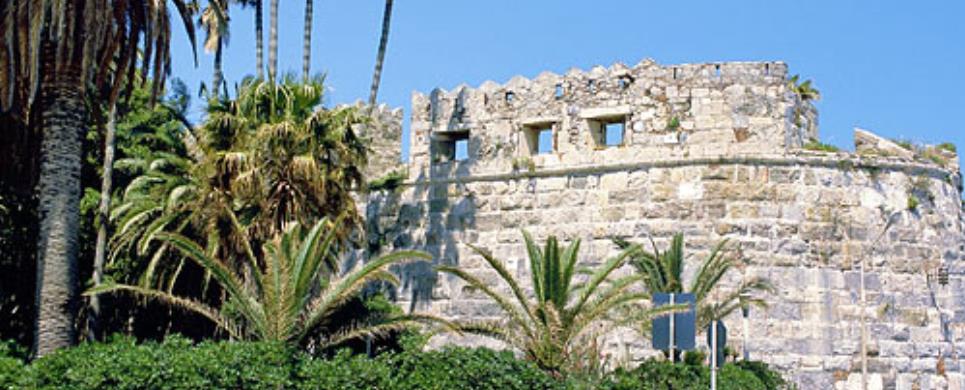
KOS (Town) DODEKANISSOS
It is situated in the
entrance of the Kos harbour
on a place where, in antiquity, there was an island, communicating with the inland through a brigde, that's still preserved
today (the bridge of the Phoenicians' street).
It is formed of two
defensive precincts.
The interior one has four circular towers in the corners; the southeastern tower forms part of the
exterior precinct,
which is larger than the first, with massive bastions on the four corners, battlements and gunports. The two precincts are separated
by a large moat and communicate with a drawbridge.
The castle
was built of local stone as well as
parts of ancient buildings
(columns, architraves, bases etc.) from the ruins of the ancient city.
On the upper part of its masorry, one can see many blazons.
Over the main gate
one sees an hellenistic frieze
with masks and garlands. On the gates' ceiling (central gate, Carmadino gate) there are basalt columns placed obliquely, which come
probably from the early christian basilica of Limen.
From travellers' descriptions, we know that the interior precinct was built a little before the end of the 14th century when the
sultan Bayazit I was attacking the city. The oldest remaining part of the castle is the circular tower to the left of the draw bridge, through
which the two precincts communicate, and bears the blazons of two Grand Masters: De Lastic (1437 - 1454) and de Milly (1454 - 1461).
The exterior precinct is posterior to the interior, its construction began in 1495 by the Grand Master D' Aubusson, continued by D' Amboise
and completed by Del Carretto in 1514.
On the northen side, between the two precincts, there was a warehouse made by the knights; it was restored during the
Italian occupation and today it is used as a museum, where one can see altars, sculpures and inscriptions.
LIPSI (Island) DODEKANISSOS
It is located to the SE of the village of Lipsi..
LOUTRA (Settlement) KYTHNOS
Oria Castle, for a short time a pirate hideout, was first occupied
in the tenth century AD and served as the island's capital during the Byzantine
period and Latin rule.
This extract is cited May 2003 from Kythnos
Association of Tourism Professionals tourist pamphlet.
MEGALO CHORIO (Village) TILOS
A medieval castle.
The castle, which has a triangular ground plan, was built on the place of a hellenistic citadel, to the north of Megalo Chorio.
In the interior, one sees ancient and medieval ruins, cisterns and the Taxiarches church, with 14th - 15th century frescoes, built obviously over the ruins of an ancient temple.
This text is cited Mar 2003 from the Hellenic Ministry of Culture URL below.

MEGISTI (Village) DODEKANISSOS
A Byzantine Castle, 2 km to the W of the village of Megisti.
MONOLITHOS (Village) RHODES
A Venetian Castle built in 1476.

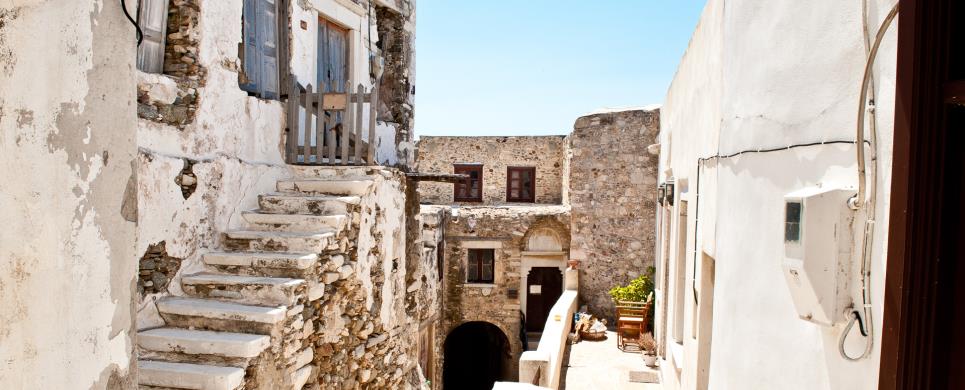
NAXOS (Town) KYKLADES
Tel: +30 22850 22725, 24150
Fax: +30 22850 22725
Border tower
protecting the fortress (Castro) of Sanoudos
in Chora, Naxos. The wall surrounding the fortress is pentagonal and has three gates. The Glezos tower (Krispi)
stands near the northwestern gate and extends in part along the western and northern
side of the fortress (Castro). It has four levels (floors) and it is the only
tower in Naxos that has also a round tower attached to it.
In 1207 Frankish rule was established in the Aegean. The Venetian
Markos II Sanoudos built the fortress of Chora in Naxos with circuit towers, one of which, the Glezos tower
(Crispi) is still preserved. Over the main entrance to the tower is the
coat of arms of the Crispi family.
The tower has been ceded by its owner, Mr. Petros Glezos to the Archaeological
Service, to become home of the first Byzantine Museum in the Cyclades.
NISYROS (Port) DODEKANISSOS
PALIOKASTRO (Castle) IOS
At the eastern side of the island, above the beach of St. Theodotos, lies a very interesting archaeological site: it is the surrounding wall, 2,5 m high, of a fort. The church of the Virgin Maria Paleokastritissa is built on top of this fortress.
PANTELI (City quarter) LEROS
The Castle is surrounded by three precincts: the interior one is the
oldest, built with material, taken by byzantine buildings.
Its shape is polygonal and bears the blazons of Querini (1453) and
the Grand Master De Lastic (1437 - 1454). Inside the castle, there are the chapels
of St. George with the blazon of the Grand Master D' Amboise (1503 - 1512) and
of the Holly Trinity. The castle' s precinct bears also D' Amboise' s blazon with
the date 1509.
There are also other ruins inside the castle, as well as the church
of the Virgin, built in the place of a byzantine church, during the ottoman occupation.
This text is cited Sept 2003 from the Hellenic Ministry of Culture URL below.



SERIFOS (Village) SERIFOS
This defensive settlement is built on a hill by the Seriphos port.
In the 15th century this was the see of the Venitian rulers of the island and
specifically of the Picchieli.
This defensive settlement still preserves its medieval fortification.
Although Seriphos was ruled by three Venitian families, the Giustigniani, the
Ghizi and the Picchieli, this is the only remnant of them that still exists.
This text is cited Sept 2003 from the Hellenic Ministry of Culture URL below.

XIROKAMBOS (Village) LEROS
AGIA MARINA (Village) KASSOS
FOLEGANDROS (Island) KYKLADES
From the small hamlet of Karavostasi, which is also the island's port,
one can get to the cave of Chrysospilia ('Golden Cave') in thirty minutes by caique.
It is thought to be one of the largest caves in Greece, but remains unexplored.
It is ten metres from the sea and its vault is propped up by stalagmites in strange
formations.
Aside from the impressive stalagmites and stalactites which form its
interior decor, the cave is also of interest as a significant archaeological site.
Human skeletal remains, pieces of broken pottery and countless male names have
been found here. It is believed that the cave was a place of worship for the ancient
Greeks and it is possible that the protecting gods of the island were worshipped
inside it.
This text is cited Apr 2003 from the Development Association 21th Geographical Unit URL below, which contains images.


The cave is situated on the North-Eastern cliff of the island. It
has much more lithomatic decoration. The characterist is the writing of ancient
names mainly youths "KALON". There are sparely in the first room mainly
and are frequented in the very interior. There are on the walls and on the roof
of the rooms. 400 names are identified and 30-40 of them are mentioned for the
first time.
Ancient writers are mentioned the cave but mainly travellers of the
past century, they managed despite the difficulties, to go up to the first room
where are Roman basins and they mention the existence of ancient findings.
The cave is not touristically developed. It was used as a hidding
place in the recent years.
This text is cited Sept 2003 from the Hellenic Ministry of Culture URL below, which also contains image.


HERAKLIA (Island) KYKLADES
When in Iraklia one can visit the cave of Agios Ioannis (St. John).
It is the biggest cave of the Cyclades and one of the best in Greece. Consists
of a maze of incredible stalactites, stalagmites, columns and a rare kind of "cave-milk"
and it takes two and a half hours to explore it. It is situated at a panoramic
site with full view of the sea and nearby island. From the village Panagia it
takes one hour to walk to the cave.
Legend has it that sometime at the end of the 19th century, a shepherd
had lain down under a bush to seek refuge from heavy rain. When he later reached
the village, his friends noticed that at the back of his shirt there was the face
of St. John the Prodrome. They asked the shepherd to show them were he had lain,
and when they got there they discovered the entrance of the cave and icon (painting)
of St. John the Prodrome. That's how the cave got its name, and every year on
that day, the celebration held in memory of the beheading of St. John, vespers
are held at the big hall of the cave and visitros from nearby island as well as
tourists attend.


KALYMNOS (Town) DODEKANISSOS
KARPATHOS (Small town) DODEKANISSOS
MEGALO CHORIO (Village) TILOS
MEGISTI (Village) DODEKANISSOS
Receive our daily Newsletter with all the latest updates on the Greek Travel industry.
Subscribe now!